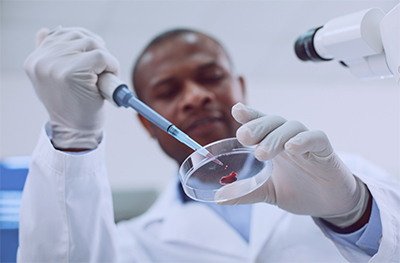Circulating oxysterol levels
In in the journal , of the Vanderbilt School of Medicine and an international team showed a correlation between certain circulating molecules and the presence of cancerous cells.
 Finding cancer before it has progressed or spread is crucial when trying to fight the disease. Despite this, early cancer detection remains a challenge. Cancers often can lie undetected without symptoms until it’s too late for effective treatment. Recent research, however, may present a new path to overcoming this obstacle.
Finding cancer before it has progressed or spread is crucial when trying to fight the disease. Despite this, early cancer detection remains a challenge. Cancers often can lie undetected without symptoms until it’s too late for effective treatment. Recent research, however, may present a new path to overcoming this obstacle.
Oxygenated metabolites of cholesterol, called oxysterols, are molecules formed naturally through metabolic processes and play important roles in mediating cholesterol and lipid metabolism. By measuring the blood levels of oxysterols in breast cancer patients before and after tumor removal, Guengerich and colleagues discovered that certain concentrations changed, indicating a potential role for them in cancer biology.
“In general, some people think that most cancer is caused by things in the environment, like smoking or the things they eat,” Guengerich said. “Turns out there’s a lot of stuff going on in our own bodies, like metabolism, that’s driving cancer.”
Oxysterols have been implicated in breast cancer , but this new research indicates that their role may be more complex than previously thought. While researchers have known for years that there are multiple types of oxysterols, it turns out that these oxysterols can behave very differently from each other when tumors grow and are removed.
Particularly surprising to Guengerich and his team was that one oxysterol, 7-ketocholesterol, or 7-keto, actually decreased in concentration when tumors grew and increased in concentration after tumors were removed. Previously, many scientists believed that .
“Even in this field, people have the idea that all oxysterols are bad, but our work indicates that that may not be true,” said Guengerich, who is a deputy editor of the Journal of Biological Chemistry. “Levels of individual oxysterols are going up and down in relation to a cancer, so they’re not necessarily all good or all bad, but all have their own type of biology.”
This richer picture of oxysterol behavior gives rise to the hope that the monitoring of oxysterols could become an early warning system for cancer, although Guengerich warns that we’re not there yet. Studies are needed to determine how oxysterol levels change after tumor removal and how those changes correlate with survival rates. Researchers also want to determine if changes in oxysterols indicate cancer metastasis.
This research project was limited; only 24 patients were involved and the study lacked healthy control subjects for comparison. “Cancer is a heterogeneous type of disease, and we need more people and time to be clinically useful,” Guengerich said.
Oxysterols such as 7-keto may not yet be useful biomarkers, but they present a promising avenue of research and raise new questions: What causes the change in oxysterol levels? Are these changes a cause of breast cancer or a side effect? When answers are found, they could lead to new tools in the fight against breast cancer.
Enjoy reading ASBMB Today?
Become a member to receive the print edition four times a year and the digital edition weekly.
Learn moreGet the latest from ASBMB Today
Enter your email address, and we’ll send you a weekly email with recent articles, interviews and more.
Latest in Science
Science highlights or most popular articles

From the journals: MCP
Protein analysis of dopaminergic neurons. Predicting immunotherapy responses in lung cancer. ZASP: An efficient proteomics sample prep method. Read about papers on these topics recently published in Â鶹´«Ă˝É«ÇéƬ & Cellular Proteomics.

Unsheathing the role of myelin lipids in Alzheimer’s disease
Xianlin Han, an ASBMB Breakthroughs speaker, discussed his pioneering work on lipidomics and the role of sulfatide lipids in Alzheimer's disease.

Ten interesting quotes from the JBC archives
Older papers include archaic quirks and long-abandoned biological concepts. Some show flashes of ideas that grew into their own fields, and others show that some things never change.

Lipid biomarkers hold clues to stroke recovery
Scientists at the University of Arizona found that a lipid mediator accumulates with the waves of inflammation associated with stroke and foamy macrophages.

From the JBC archives: Madness, indoles and mercury-based cathartics
A 1907 paper sought to resolve an ongoing question of whether indole, a bacterial molecule in the gut, could cause insanity if overproduced.

From the journals: JBC
Linking modified cysteines to cell migration. Recognizing protein tags for degradation. Disrupting C. difficile toxin production. Read about recent JBC papers on these topics.

